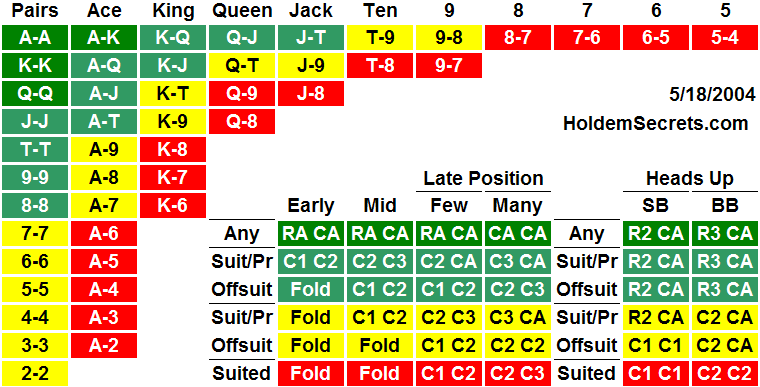Pre-Flop Betting Chart
by Rich McComas (updated May 18, 2004)
The table below includes my recommendations for pre-flop betting in low-mid limit Hold'em. This chart was created to assist new poker players, and attempts to illustrate (1) My list of 47 playable starting hands, (2) Groupings by stoplight colors (green-yellow-red), (3) How suited and non-suited hands compare, (4) Which hands you should fold by position, (5) Which hands you should call by position up to a certain number of BBs, (6) Which hands you should raise with, (7) How high you should call if someone raises behind you, and (8) How you should play the hands in heads up play (either in SB or BB). This is a lot of information for a small chart designed to be printed on the back of a business card.

(Colors) The colors are from a stop light, shades of green, yellow and red. Any card combination not shown on this chart should not be played unless you are stealing blinds from weak players, etc.. Raising more than these recommendations would be called semi-bluffing. The grid in the lower right suggests what you should do, raise or call a certain number of Big Blinds.
(Early, Mid & Late Position) This chart shows betting by position assuming that there are many players. Late position is divided into two types of play, when many are in the pot versus few in the pot. The first number is the number of big blinds to (R)aise or (C)all on your first opportunity to bet, and the second number is the maximum amount to (C)all with this hand prior to seeing the flop. If the Chart says R2, and it the bet is already at two blinds, then you are to call. CA refers to Calling Any raise.
(Heads Up - SB & BB) This is for heads up play, indicating whether you should call or raise when in the small blind (SB) or big blind (BB).
For instance, if your hand is a King & Nine of the same suit, then you have a yellow caution light, so follow the grid to the first yellow box after the words "Suit/Pr."
- In Early Position: Fold
- In Mid Position: Call up to one big blind, and if it comes back to you a second time, call up to two big blinds.
- In Late Position w/ Few players in the pot, call up to two big blinds, and up to three if it comes back to you a second time.
- In Late Position w/ Many players in the pot, cal up to three big blinds, and if it comes back, call anything.
- Heads Up in the SB: Raise to try to steal the BB, and call if the big blind raises you back.
- Heads Up in the BB: Call.
EXERCISE: Using the chart above, think of several examples where you might want to reconsider the raise/call advice offered. For instance, if two tight players (who probably both learned using a similar chart) have raised ahead of you, and you have AKs, do you still want to re-raise them from middle position? How might the chart or betting advice change for high-limit games? What about micro-limit tables where more than 50% of the people typically see the flop?
©2003-2004 www.holdemsecrets.com.